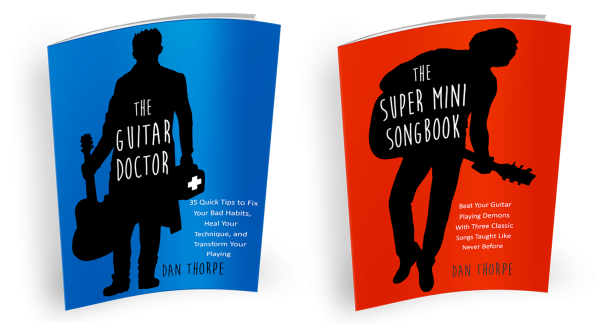Learning a handful of guitar strumming patterns is essential for most guitarists. Yet so many spend a huge amount of time on everything EXCEPT rhythm guitar. They spend way too much time on chords, scales, and just noodling around. So much so that they don’t have the time to work on some of the things that really count – such as rhythm guitar.
If guitarists were more efficient, most would be much better players in a much shorter space of time. One area that lacks any efficiency whatsoever is their rhythm playing, and in particular – strumming.
Today, we will solve this.
First though, if you find your strumming sounds bad but you don’t know why, watch this short video for a solution…
I specialise in teaching older students the acoustic guitar (usually fingerpickers and strummers), but these tips apply to everyone.
I must say though, there are many areas where guitarists really struggle and I have outlined the 27 biggest ones (along with the solutions) in this post on how to play guitar.
Now then, it doesn’t matter if you are a folk player, a pop player, or a rock player, at some point you are going to want to strum the guitar.
…So let’s begin strumming, amigo!
3 Simple Guitar Strumming Patterns on to How to Strum a Guitar Like a Pro
We are going to keep it simple today and learn just 3.
The following three strumming patterns are all taken from my Amazon book, The Ultimate Guide to Strumming.
(That book has countless five-star reviews – do ignore the one person moaning about it. Can’t please everyone, haha).
Anyway, the following guitar strumming patterns are 3 of the most commonly used patterns in folk, rock, pop, and indie music…
Although they are used frequently in genres ranging from neo-soul to progressive hardcore metal too, so it really is essential that you learn them (and these strumming patterns even cater to the goths too!).
Have a listen to all the strumming patterns in action. These are short chunks of songs or riff ideas that I have created over time using examples of all the strumming patterns.
…And if you can’t read the strumming charts below, take a look at our guide on how to read strumming patterns.
Strumming Pattern 1 – The Ultimate Strumming Pattern
The ‘Ultimate Strumming Pattern’ uses a combination of quarter and 8th notes.
By the way, the name of this pattern was something I made up as a joke, but the name stuck with my students!
Anyway, it is worth getting a good understanding of these and making sure you’re comfortable playing them before attempting the strumming pattern (that is not essential, but it will help). For more help with rhythm, check out this video on sub-divisions for the guitar created years back, which is still very powerful now.
This is an incredibly popular pattern to strum on the guitar. It makes a good substitute for other more complex strumming patterns and is also a good ‘go to’ strumming pattern that all guitarists can call on frequently when in doubt.
Songs That Use The Ulitmate Strumming Pattern
- Van Morrison – “Brown Eyed Girl”
- Green Day – “Good Riddance (Time of Your Life)”
- The Calling – “Wherever You Will Go”
- Foo Fighters – “Times Like These”
- The Fray – “How to Save a Life”
Listen to the ‘Ultimate Strumming Pattern’ in Action
Pop
Chords used:
G Major, D Major, E minor, C Major
Play-along:
Capo 2nd fret
(G, D, Em, C) x 4
Rock
Chords used:
F5, E5, G5, A5, B5, C5
Play-along:
No Capo
(F5, E5, G5, A5, B5, C5 ) X 4
As you can hear in the above examples, the same strumming pattern gives you a very different sound depending on what ‘sound’ you are after. The overall feel is the same for both the pop and rock versions …but the end result is pretty different.
A REALLY common strumming pattern mistake I see a lot…
Before we move on to the next strumming pattern, let me ask, how many exact strumming patterns do you actually know how to play?
My experience of teaching beginners, intermediates, and even some players who have mastered many areas of guitar, is that they don’t know how to strum like a pro.
So now, let’s test you…
Stop reading for a second, pick up your guitar, and play me your favourite strumming pattern. Then come back and read the rest.
What often happens when I ask a student to play me a strumming pattern is…
I either get a blank look and they say they don’t know any, or they quickly panic and try to think of a song in their head and then play the strumming pattern from that song.
Be honest, is this what you just did?
There is nothing wrong if you did, you just haven’t been made aware of the importance of being able to call on a variety of different strumming patterns at will.
How great would it be if you were able to strum a certain pattern on your guitar at any given time – and one that relates to a specific genre or feel you are after?
Well, keep reading as that is what this post is about.
Okay, let’s move on to pattern #2 and it’s a cool one…
Strumming Pattern 2 – The Indie Rock Strumming Pattern
The Indie rock strumming pattern uses a combination of quarter, 8th, and 16th notes, so do get comfortable playing these before attempting this strumming pattern.
The accents on the 2nd and 4th beats are integral to this pattern. Loads of modern rock and pop songs use this pattern to great effect.
The first half and the second half of the pattern are the same and often the chord change is made on beat 3.
Update – these days I teach this using all downstrums except for the quick 16th note upstrums on the ‘a’ of beats 2 and 4. This makes it easier to play and gives the strumming pattern the more urgent sound that it requires.
Songs That Use The Indie Rock Strumming Pattern
- Blur – “Country House”
- Eagle Eye Cherry – “Save Tonight”
- Red Hot Chili Peppers – “Dani California”
- Shawn Colvin – “Sunny Came Home”
- Oasis – “D’You Know What I Mean?”
Listen to the ‘Indie Rock Strumming Pattern’ in Action
Pop
Chords used:
A minor, F Major, C Major, G Major
Play-along:
Capo 2th fret
(Am, F, C, G)
Note: All bars in this example are split bars
Rock
Chords used:
F5, Ab5,E5, Bb5, C5
Play-along:
No Capo
F5, Ab5,E5, Bb5, F5, Ab5,E5, C5
Note: All bars in this example are split bars
Both the pop and rock versions of the ‘indie rock strumming pattern’ give off the same vibe, but with totally different effects.
Strumming Pattern 3 – The Modern Strumming Pattern
The Modern Strumming Pattern uses a combination of quarter, 8th, and 16th notes, so again do try to have a good understanding of these and make sure you are comfortable playing them before attempting this strumming pattern.
Songs That Use The Modern Strumming Pattern
- Oasis – “Live Forever”
- Passenger – “Let Her Go”
- Bob Dylan – “Knockin’ on Heaven’s Door”
- Ed Sheeran – “Skinny Love”
- Radiohead – “Fake Plastic Trees”
Listen to the ‘Modern Strumming Pattern’ in Action
Pop
Chords used:
E minor, Cadd9, G, Dsus4/F#
Play-along:
Capo 6th fret
(Em, Cadd9, G, Dsus4/F#) X 4
Rock
Chords used:
Drop D tuning (D5, E5, A5, F5)
Play-along:
No Capo
A Quick Summary of the 3 Most Important Guitar Strumming Patterns
I hope you enjoyed this post and you enjoyed the examples of these three guitar strumming patterns.
Remember, on the guitar, most guitarists have a solid base of “stock” ideas.
For example, many guitarists are pretty good at chords and can play minor chords for sadder-sounding music, or major 7ths for a more jazzy feel…
…Yet they can’t do this sort of thing with strumming patterns.
…But to be honest, the rhythm is often more important than the chords. (If you want to learn the most important chords though, do check out this guitar chord chart featuring the 32 essential guitar chords.)
Why You Need to Learn Some Strumming Patterns on the Guitar
Really, it is relatively simple for most guitarists to make BIG changes to their playing with strumming.
A few specific strumming patterns such as these and some practice so you can play them in your sleep will set you up for the rest of your guitar-playing days.
Not only will these strumming patterns make you a better-sounding player, but your understanding of rhythm will also improve, the timing of your songs will improve, and your ability to create stunning rhythm parts of your own will increase dramatically.
It is possible. To do so though, you will need a solid repertoire of strumming patterns to call on.
I hope this guide helps you learn how to strum a guitar like a pro. Once you get good at learning the above examples, try to learn how to adapt your guitar strumming patterns – doing so will allow you to blossom and truly develop as a rhythm guitarist.
Leave a comment below and let me know what your favourite strumming pattern is from above!










